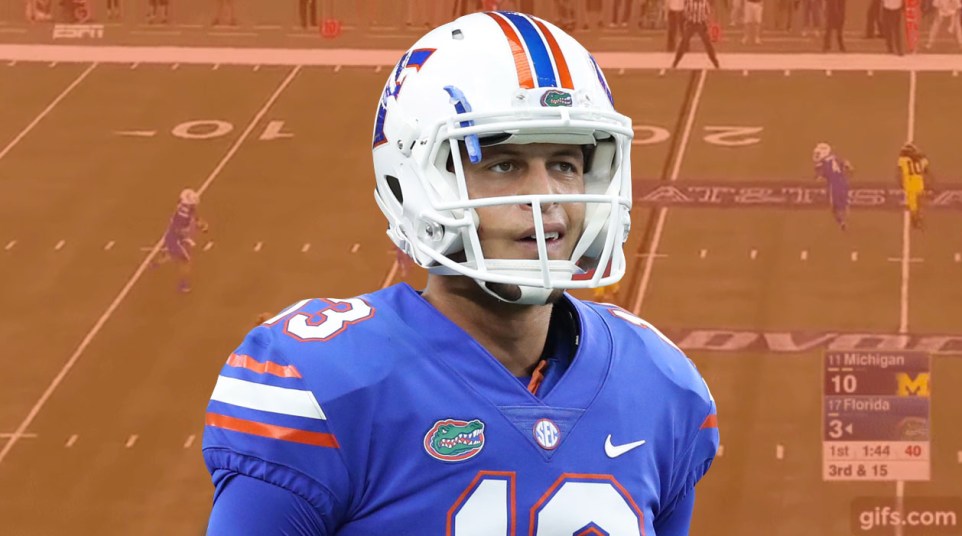
Film Study: Searching for signs of offensive life at Florida
Even if you’d never seen Florida play another game, the UF offense was ugly enough in its season-opening loss to Michigan that you would have been justified in wondering how the Gators could possibly move forward. The entire unit was inept, shuffling between two ineffective quarterbacks while failing to generate anything positive on the ground. Ultimately, aside from a pair of defensive scores that made the final score much closer than the reality, the offense finished with more fumbles against the Wolverines (four) than points (three).
Still, the despondent reaction to the loss had less to do with the performance itself than with just how depressingly familiar the whole thing was. In a way, the debacle was a perfect summary of the problems have steadily gnawed away at Florida’s offensive prestige for years. This is an attack that, including the Michigan loss, has now failed to top 20 points in six of its past seven games dating to last November.
Among SEC offenses in 2016, Florida finished dead last in total offense and 12th in scoring. (Aided significantly in the latter case by six touchdowns on defense and special teams.) No other SEC team last year averaged fewer first downs, scored less often in the red zone, or threw more interceptions. Over the past five years, no other SEC team has shuffled through as many quarterbacks. The first sour note of 2017 was merely an extension of all of the above.
No wonder the vibe entering this weekend’s must-win date with Tennessee is all negative: There’s little trust behind center, arguably less in the offensive line, and almost none whatsoever in the beleaguered offensive coaches. The most dramatic change from the opener is a plan to move the offensive coordinator, Doug Nussmeier, from the sideline to the press box. Meanwhile, a wave of preseason suspensions continues to claim, among others, last year’s leading rusher (Jordan Scarlett) and receiver (Antonio Callaway) for the foreseeable future.
Amid the doom and gloom, are there any glimmers of hope? Is it really possible that a program whose glory years were built on prolific offenses, which routinely recruits among the national elite, is somehow as devoid of difference-makers on that side of the ball as it seems? And with a crucible game on deck, how can the Gators begin to move forward again from a dead stop?
In Franks We Trust. The top priority is settling on a starting quarterback, and it’s no secret coaches would prefer for Feleipe Franks to be the one to take the question out of their hands. For one, there’s no apparent upgrade from Franks to Malik Zaire, the grad transfer from Notre Dame who replaced Franks in the second half against Michigan; if anything the offense looked even worse from that point on. (Zaire didn’t take a snap in Michigan territory until the dying seconds of the game, with the score well out of reach following Zaire’s casket-sealing fumble in his own end zone.) But the Gators also have more riding on Franks long-term — if not as the budding star his recruiting rankings promised, then at least as a raw talent who should be comfortably entrenched as QB1 by the end of his second year on campus.
Even if Zaire were to somehow emerge as the better option for the rest of 2017, at this point that would almost certainly say more about Franks’ failure to take hold of the job than it would about Zaire’s progress as a fifth-year senior. Given the expectations that met their respective arrivals — Franks as a blue-chip prospect, Zaire as a high-profile transfer with starting experience under his belt — the fact that neither has been able to put any distance on the other is disappointing. Zaire, though, is a stopgap with limited upside, all of it short-term.
Franks is the future: Whether it’s now or two years from now, Florida has too much invested in the gem of Jim McElwain’s first full recruiting class to watch him go the way of John Brantley, Jeff Driskel and Will Grier. To a large extent McElwain’s job depends on his preventing that from happening. Which is why it will be Franks taking the first snaps Saturday, and why he should be given every opportunity to keep on taking them. Because the long-term implications if he can’t are bleak.
And while he was clearly overmatched in his first career start, Franks did offer a few glimpses of his potential in his abbreviated outing against Michigan. On the second play of the game, Florida lined up in an empty backfield with three receivers bunched to the short side of the field and two split wide to the opposite side; Michigan responded aggressively, with 10 defenders lined up within 5 yards of the line of scrimmage and a single safety deep. When the Gators sent one of the trips receivers, tight end C’yontai Lewis, in motion before the snap, Michigan safety Josh Metellus followed, signaling man-to-man coverage across the board.
Franks registered the signal, found the one-on-one matchup he wanted — Joshua Hammond, in the slot, running a fade against nickel corner Lavert Hill — and calmly dropped a dime in between Hill and safety Khaleke Hudson for a 34-yard gain:
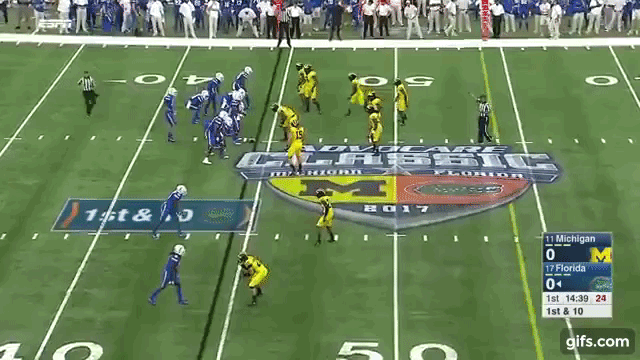
That stood as Florida’s longest gain of the day, Franks’ best throw (by far), and the set-up for the Gators’ only offensive score, a 46-yard field goal by Eddy Pineiro. In making the case for Franks’ arm talent, for the time being it will have to suffice as Exhibits A, B, and C.
His only other downfield completion came later in the half, when he victimized Hill again on a 31-yard lob to receiver Tyrie Cleveland …
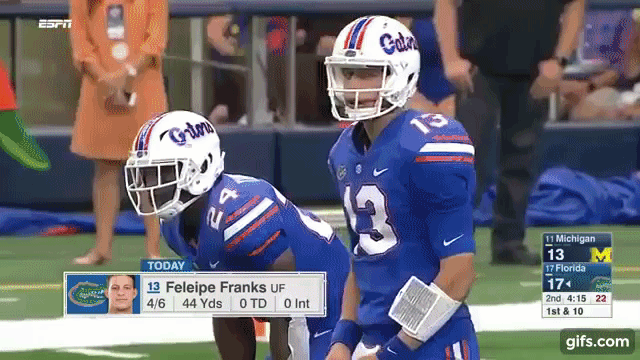
… although in that case most of the credit probably goes to Cleveland for adjusting to what appears to be a badly underthrown ball. (See below for more on Cleveland.) A more generous interpretation is that Franks deliberately left the throw short to keep it out of the reach of the safety, No. 23 Tyree Kinnel, and to give his receiver a chance to come back to the ball as the corner overran him; based on the rest of Franks’ performance that would be very generous. Either way, this attack is in no position to be nitpicking a 30-yard gain.
The other positive takeaway from the opener is that Franks appears to be more mobile than his 6-6 frame and generic “Pro Style” designation might suggest. When a designed rollout pass broke down on 3rd-and-15 in the first quarter, Franks deftly reversed field and outran his pursuers for what can only be described as an unlikely first down:
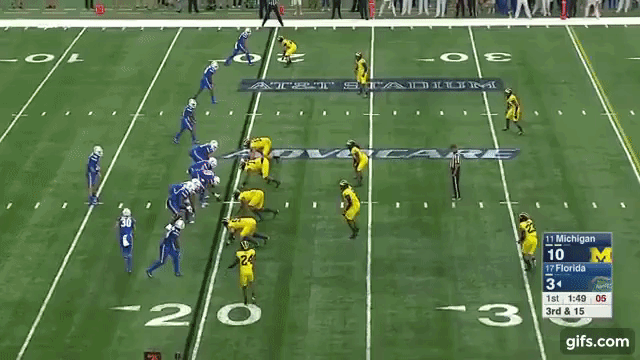
Specifically, he outran No. 3 Rashan Gary, the most coveted player in the entire 2016 recruiting class and a future All-American, first-round draft pick, etc. Franks won’t have any more athletic defensive ends chasing after him in the SEC, and while he might not be asked to run often, it’s nice to know his legs are a potential asset when he needs them. (Now, if he can just hold on to the ball …)
The Leftovers. Beyond the void at quarterback, the most frustrating aspects of the Gators’ malaise on offense are a) The perennial absence of a reliable, top-shelf playmaker among the skill positions, and b) The constant flashes of big-play potential that fail to come to fruition with any kind of consistency. It goes without saying that the Gators have talent; recent alums Jordan Reed, Mike Gillislee, Matt Jones, Kelvin Taylor, Demarcus Robinson, Quinton Dunbar and Trey Burton are all holding down spots on NFL rosters. The maddening part is how visibly it’s been wasted.
At the moment, that’s most obviously true for the most prominent of the current suspensions, Jordan Scarlett and Antonio Callaway, both of whom were poised for central roles as juniors. Normally, this would be considered a breakout year for Callaway, especially, who averaged nearly 16 yards on 89 catches in his first two seasons; when he’s on the field, he’s the most productive and explosive receiver at Florida since Percy Harvin. But Callaway has endured multiple suspensions, and with his status in limbo again it’s unclear if or when he’ll be on the field in a Gator uniform again.
In his absence, the resident big-play threat (if only by default) is Cleveland, a touted, 6-2 sophomore capable of bringing some legitimate juice to the downfield passing game. Among his 14 receptions as a true freshman was Florida’s biggest offensive play of 2016, in every respect — a 98-yard, catch-and-run bomb from since-departed QB Austin Appleby that turned out to be the difference in the Gators’ division-clinching win at LSU last November:
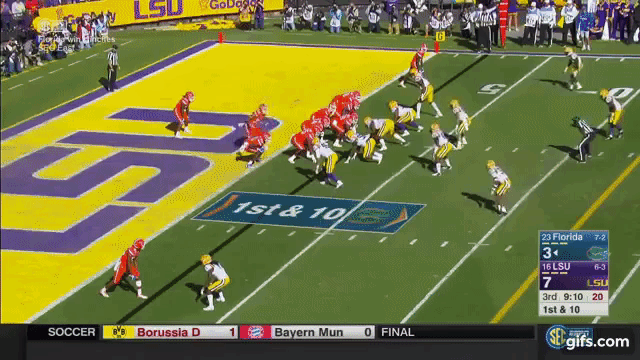
Against Michigan, Cleveland proved willing and able to come down with less-than-perfect throws in his general vicinity, first on the deep ball from Franks discussed above, and later on a third-down throw from Zaire that required him to climb the ladder for a 22-yard gain:
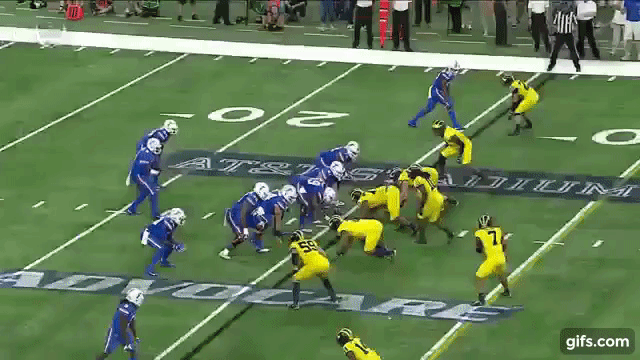
For the game Cleveland finished with four catches for 56 yards; if he can be counted on to make that type of play on a weekly basis, he’s got All-SEC potential. In the meantime, he and fellow sophomore Josh Hammond both top out at “intriguing.”
The less explosive but more reliable weapon in the passing game is tight end/H-back DeAndre Goolsby, who hauled in 38 catches last year as a junior and can present a serious matchup problem if the Gators are able to get him isolated against a linebacker downfield. (That’s more likely to happen on run downs, when defenses are more likely to be concerned with countering his size as a blocker.)
Goolsby was at his best in last year’s SEC Championship loss to Alabama, posting near career highs for receptions (7) and yards (91); in fact, most of that production came on a single drive before halftime, on which Goolsby had three catches for 52 yards, capped by a 25-yard touchdown from Appleby when the Crimson Tide got caught trying to cover him with an inside linebacker on 1st-and-10:
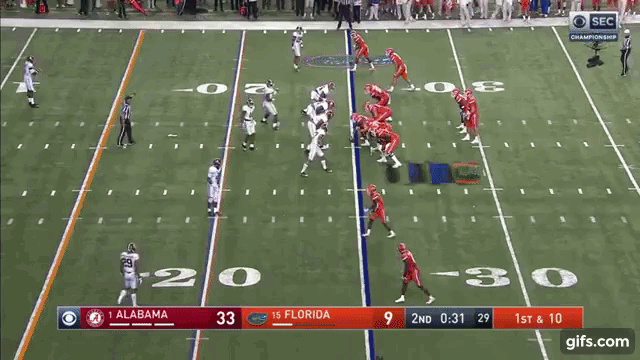
Two problems with replicating that: One, Goolsby didn’t record any statistics vs. Michigan and isn’t certain to play against Tennessee due to an unspecified injury. (Although McElwain sounded optimistic about Goolsby’s status earlier this week, and the latest depth chart lists him as a co-starter at tight end with C’yontai Lewis.) Two, attempting to create favorable matchups based on the premise that the defense must respect the run requires the defense to actually, you know, respect the run.
Even with Scarlett in the lineup for every game last year, Florida finished last in the SEC in rushing yards per game and per carry, after finishing next-to-last in rushing offense in 2015. Against Michigan the Gators netted 11 yards rushing on 0.4 per carry. With Scarlett on ice indefinitely, the only remotely hopeful note on the ground is the still-hypothetical possibility of a Wildcat package featuring true freshman Kadarius Toney. And that’s only because it has yet to definitively fail.
Otherwise, again, fans have fleeting glimpses of potential greatness: See senior Mark Thompson eluding half the Iowa defense en route to an 85-yard touchdown on a screen pass, or sophomore Lamical Perine going full-on Beast Mode against LSU. Thompson had a 47-yard TD run against Michigan negated on what looked to me like a dubious holding penalty. Only glimpses, though — it’s been ages since Florida boasted a competent ground game, and behind Scarlett the depth chart doesn’t even feature any particularly hyped recruits on whom to project a sudden surge. Improvement is strictly in the hands of the offensive line.
To Saturday and Beyond. In retrospect, McElwain will probably regret pulling Franks against Michigan, if he doesn’t already. It seemed reasonable enough in the moment; the offense was stagnant, Franks had just fumbled for the second time, and Zaire certainly didn’t sign up for one-year tour just to watch a bad unit from the bench.
But Zaire’s failure to provide any sort of spark himself only drove home the reality that, for better or worse, the offense is hitched to the younger, more physically gifted player. In that sense, the cancellation of last weekend’s Northern Colorado game due to Hurricane Irma really did cost the Gators a chance to get Franks some meaningful reps and begin to establish a comfort zone as the starter without having to worry that the next series will be his last.
That said, if Franks leads another start-to-finish dud with no signs of progress against Tennessee then all bets are off. Prior to this month Florida hadn’t loss its season opener in decades; an 0-2 start is unthinkable, especially with the annual dates against LSU, Georgia and Florida State still on deck. Depending on the margin this week, even next week’s trip to Kentucky would start to look pretty dicey.
On the other hand, Saturday could also turn out to be an ideal stage for the new generation on offense to begin to emerge from its underachieving predecessors’ shadow: At home, against an equally shaky division rival, opposite a defense that figure to allow for plenty of margin for error. The Gators are, remarkably, listed as five-point favorites against the Vols. That spread is based almost entirely on the strength of the defense, but also, to some extent, on the simple fact that any group with the basic talent level on hand in Gainesville has the potential to gel into something special very quickly.
With the exception of Goolsby and slot receiver Brandon Powell, both seniors, the core group of skill players — Franks, Cleveland, Hammond, Thompson, Perine, wide receiver Freddie Swain — are all at the start of just their second year in the program. (Thompson, a senior, arrived along with last year’s freshman class as a JuCo transfer.)
The offensive line is more experienced, but still doesn’t feature a single senior on the two-deep. They can’t grow up into the finished product fans are eager for them to be in one night. But they do have an opportunity to take a concrete step toward being where they want to be in early December, by which point the opening-day disaster in Arlington ought to be a very distant memory.
